The pairings of the next round are out. You have around 18 hours to prepare against your upcoming opponent.
What do you do at this time? And what would a Grandmaster do in this time?
That is what I am going to answer in this article.
The short version is:
- Gather information on the opponent
- Analyze the information; find out weak spots
- Take an opening decision
- Analyze and remember your opening decision
I will do steps 1-3 in the evening as soon as the pairings are out. It helps me fall asleep if I know I have taken a good decision for the next game.
Step 4 is done 2-4 hours before the game actually starts.
Note that this process is very personal.
Some like to prepare at night, some in the morning.
Some prepare a lot, and some are recharging for a big fight ahead.
No matter what routine you prefer, certain things apply to everybody and that is what I am going to focus on in this article.
1. Gathering Information (5-10min)
First things first, you need to find information to work with. You can get this information by gathering past games of your upcoming opponent.
The stronger your opponent, the more information you will find. (there will be more games in the Database available to you).
Most people will hasten this first step and the whole process takes a hit. I recommend doing things thoroughly from the get-go.
You might have to dedicate 2-5 minutes longer until you start your preparation, but you make sure you have all the information in the right place.
From preparing with the wrong color to preparing against the wrong opponent, to simply having chaos and preparing against old games, I have seen everything.
Even GMs do this process wrong or at least don’t do it 100 percent correctly. Investing a short amount of time to organize everything right will pay off multiple times later on.
Mega-Database
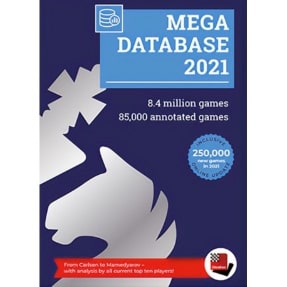
The easiest way to find games of your opponent is to have an updated Mega-Database and search your opponent in there.
Disclaimer About Chessbase Products
At the risk of repeating myself: I am using this product since 2010, but am not too fond of the values of the company (Chessbase).
Because of a Sponsorship with the Swiss Chess Federation, I have gotten all the Mega-Databases and Chessbase Programs for free for the past 10 years. The quality is the best I have seen on the Chess market.
But the products are pretty pricey and as I said, the company’s values seem dubious. What they did with Fat Fritz 2 was very strange that I actually confronted them about it.
Their first reaction was quite aggressive as they had no feeling of any wrongdoings; shortly after they stopped responding altogether.
I would love to use something else but the product is simply best for professional use. As a result, I still have to use it until there are decent alternatives become available on the market.
Why am I even telling you about this?
Because I would like to provide my audience with 100% of the picture and be as transparent as possible. Whatever you do with that information is up to you.
If you decide to buy the product, I would strongly recommend AGAINST purchasing the update every year (unless you are aspiring to be a professional player).
As you will see soon, there is a free way to get most of the new games into your existing database. For an Amateur player that is more than enough.
Free Resources For Finding Classical Games
I understand if you don’t want to buy this product. That is why I have enlisted some free online resources below.
You may find it more challenging to do all the same steps, especially with an inferior User Interface. But after all, you get what you (don’t) pay for.
By using the free products, you simply have to be a bit more imaginative and check out some tutorials on how to use them most efficiently.
- Chess Tempo
- Chessgames.com
- 365chess.com (they claim to be the biggest Chess Games Database Online)
If you know of some other good free software then please let me know in the comments, on Twitter, or via mail: noel@nextlevelchess.blog.
How To Update And Use Mega-Database In Chessbase
You can either update your Mega-Database via the “New games” button on the bottom left of your Chessbase. You will only have that option for the year you purchased the Mega-Database.
Or you can download all the Twics for free on theweekinchess. This takes some time but it’s free after all. Again, if you are not a professional player or aspiring to be one; I believe that this will be sufficient enough.
Make sure to update your database BEFORE a tournament. This is not something you want to spend time on during the tournament.
If you are a professional player, you should be ready to invest some money to make your preparations more efficient.
Small things matter on the top level, so not having to manually update a database will make a difference in the long run.
Finding Games Of An Opponent In Mega-Database
Now that your database is updated, you open it, click on “player” on the top left, and type in the last name of your opponent in the search bar down left.
Sadly you can’t search for the FIDE Identification Number. That would make the process so much easier.
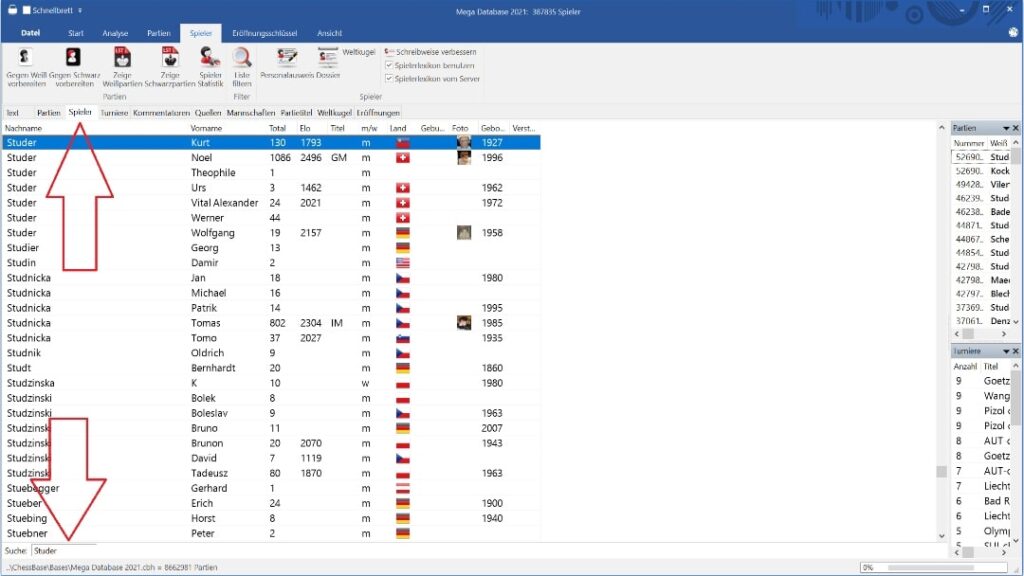
Be Careful While Searching All The Games…
Especially with non-European names or newly married players (= name changes!) there can be complications.
So, make sure to search for different combinations of Names if you feel there aren’t enough games or if games do not match. I remember playing in the World Championship 2016 in India.
The hardest part was finding the games of my Indian opponents. It seemed that the organizers and Chessbase were mixing & making errors in recording the names of players all the time.
As a matter of fact, many Indian names are actually wrong in the FIDE database. Name and surname are often inverted. Don’t ask me how or why this happens. I simply know it is true.
We sometimes had to search 4 different names (1st surname, 2nd surname, 1st name, 2nd name) to scramble all games together.
If you happen to play against a woman, shortly check their marital status and if they changed their name in the process. You will find their old games under their maiden name.
Again: Take your time! If you prepare against the wrong player or you miss out on some important games, even the greatest preparation will not help you!
Now you can click on the right player and their games start to show up on the right side of your screen. You can also click on “prepare against white/black” on the top left and you got ALL their games in there.
One thing that is important to keep in mind is:
More information is not automatically better. Whatever your opponent played 10 years ago is most likely not going to be useful to you.
So I usually filter the last 3-5 years, depending on how active the player was.
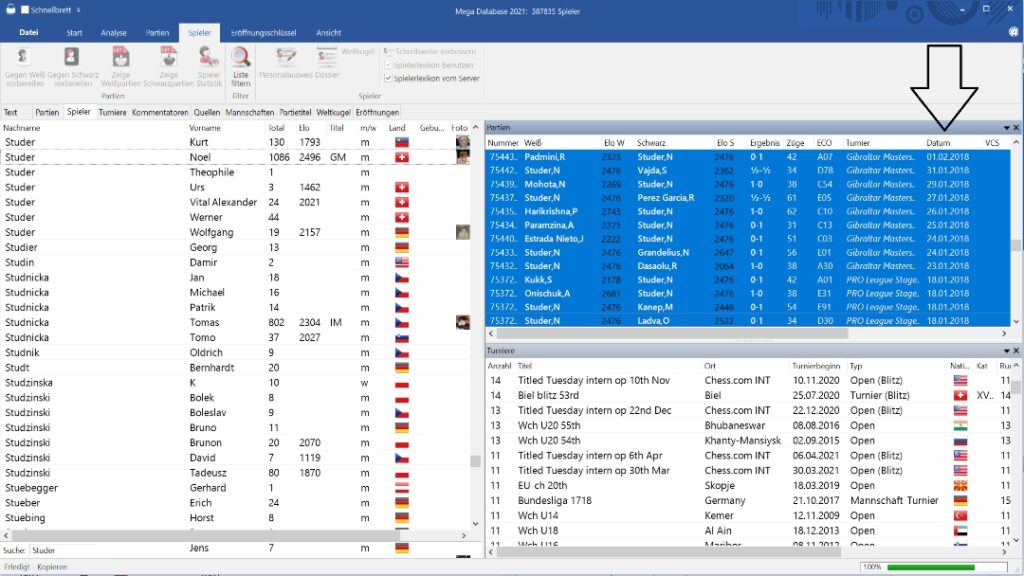
You can simply filter after “Date” (here “Datum” in German) and copy all the games from recent years. Open a new database in Chessbase and put those games in there.
You can now go into that new database, search for your opponent’s name, and start to prepare (Make sure to pick the right COLOR!).
But to get even more information, I recommend you take 2 more minutes and use totally free software to get the latest online games of your opponent in one place.
OpeningTree

As most of us are mainly playing online due to the pandemic, it is vital to get a look at the online games of your opponent as well.
Don’t weigh them the same way as OTB Classical games.
But use them as a hint of what might happen. Some players are playing rubbish openings online. If that seems to be the case, then don’t worry about those games.
However, most players try out new openings first online before they use it in OTB.
In that case, you can anticipate a “surprise” weapon and surprise your opponent by being prepared for it.
So how can you get the online games of your opponent?
By using OpeningTree! OpeningTree is a free tool that allows you to download & analyze online games played on chess.com or lichess.
You simply need to know the lichess or chess.com username of your opponent, enter it on OpeningTree, and viola you can download a PGN file of those games.
Make sure to filter the games. As Blitz/Bullet Openings have an even shorter lifetime, I would suggest downloading only games from the last 6-18 months, depending on how many games your opponent plays.
Usually for online chess, you will see some shifts in openings and understand the “surprises” your opponent is preparing.
To find the lichess or chess.com username of your opponent, use our best friend is the Internet. Search for “Name of your opponent” + lichess/chess.com username.
This search is way more efficient than searching directly on lichess or chess.com.
If your opponent ever had their name inside the chess.com or lichess profile, Google will remember that and find it for you.
Once you downloaded the Online Games, create a new Database for the Online games only and put them in there. You are now ready to go!
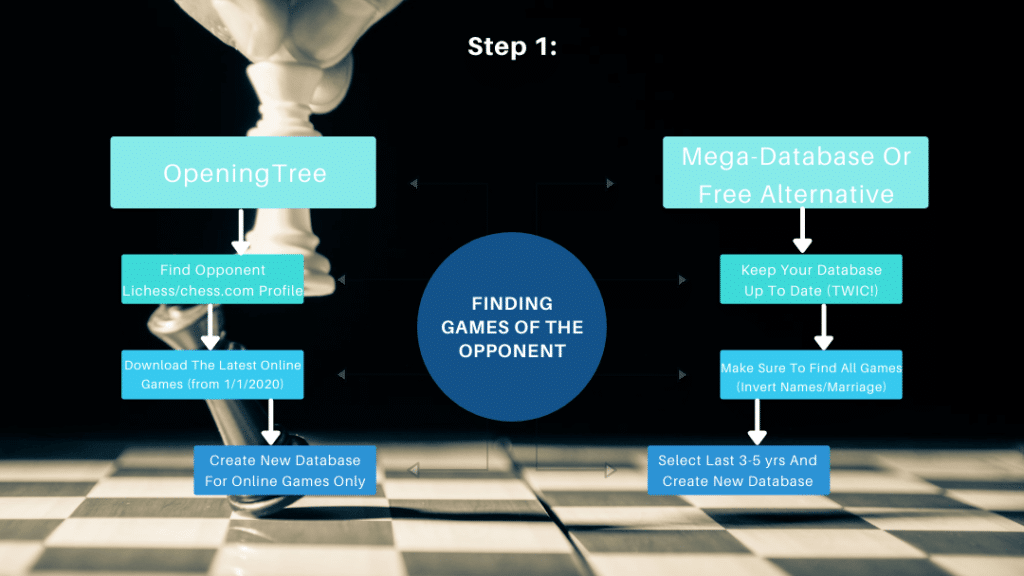
2. Analyzing Games, Finding Weak Spots (15-45min)
Now that you have all the games of your opponent in place, you can start analyzing them.
Again it is worth taking some extra minutes to do things thoroughly. The goal of this step is NOT just simply to find out which openings your opponent is likely to play.
Finding Out Strengths, Weaknesses, And Tendencies
It is also to find out what playing style your opponent has, which positions they like AND what are their weaknesses and strengths.
The better you know your opponent, the better you will be able to anticipate the moves during the game. Some players avoid complications whenever they have an easy move.
Others go for complications all the time.
If you know such tendencies you will have a HUGE advantage. You can offer your opponent two choices (a safe option and one that complicates the position). In 90% of the cases, you will know which one they will go for.
So the preparation does not only involve openings.
Learn From Other Sports
I am surprised to hear that maybe only 10% of Chess players really do a thorough investigation of their opponent.
Again, if you look into other sports, it is one of the most important steps.
Tennis players look at video footage and try to find out the opponent’s tendencies. Does the opponent like to play forehand or backhand?
How is the opponent reacting in different scenarios? What is his/her favorite shot?
Not only in tennis but in any sport where a team or an individual is preparing for the match, there will be a thorough analysis of the strengths and the weaknesses of the opponent.
I do not see any reason why we should not do the same in Chess.
Play Through Games Of Your Opponent
That is why I always start by playing through some of the latest Classical games of my opponent.
This now only takes me 5-10 Minutes MAX.
But these might as well be the most valuable 5-10 minutes of the whole preparation process!
Here are the main factors I focus on:
- Aiming for the trades: Does the player generally avoids trades or goes for them?
- Main lines or sidelines: Does the player generally goes fully into the main lines or do they avoid preparation by playing some sidelines?
- Early draws/draw offers in better positions: Does the player offer or accepts draws early in the game? This would be an indication of fear, which you can exploit in the game.
- Tactical/positional: Does this player wins most of the games in a tactical or positional manner? One of which can be assessed as a strength/a weakness.
In the optimal case, you don’t even have to do this work, because your Coach is doing it for you.
But as I said, you can also get better at doing this on your own. Start small by narrowing your analysis. If you never did it, focus on one thing only. Try to find out if your opponent likes to play tactical or positional chess.
Once you have a good eye for that, you can go on by adding a second step.
Over time and with a well-trained eye, you will find even the slightest weakness or tendency.
How I Used It Recently
A good example of knowing your opponent was my recent Banter Blitz Match against GM Larino Nieto David from Spain.
I know him a bit and he has an insane tendency to go for complications.
He needs to have a fire on the board, there is no way around it. So in that case I knew I had to play it calmly and wait for my chances.
The most important thing was not to tilt, even if I would lose some totally winning positions.
Tilting usually means going into complications, which would only worsen the whole situation.
As it happened I lost two of the first three games from winning positions. But I knew if I just focused on playing safe and not blundering, I would emerge as a winner.
Once I stabilized my play, I won 3 games in a row and took home the match.
Even without preparing any openings for the match, I had great preparation. I knew whom I was up against and in a way, I was sitting inside his head.
Anticipating his moves did not come that difficult because I knew how he thinks. This helped me clutch the match even after two unfortunate losses.
Finding Out The Opening Your Opponent Plays
Only now it is time to check the openings your opponent plays. This will probably come easy, as I guess you have done that before.
You go through the games played by your opponent and check out what they play against your openings. If you have a choice of openings, you can choose the opening based on your opponent’s repertoire.
I always do it first with the Classical games.
When I have a good overview I do the same with the Online Blitz games, but much faster. I only check if there is something new in an opening I play or a big pattern.
For example, if somebody ALWAYS plays 1.Nf3, 2.g3 3.Bg2 in Blitz but has never played it in Classical, there is a small chance he will do it one day in a Classical game. So be prepared for it.
Even if it sounds very easy, there are some pitfalls you should avoid while doing this. Here are the main ones I know of:
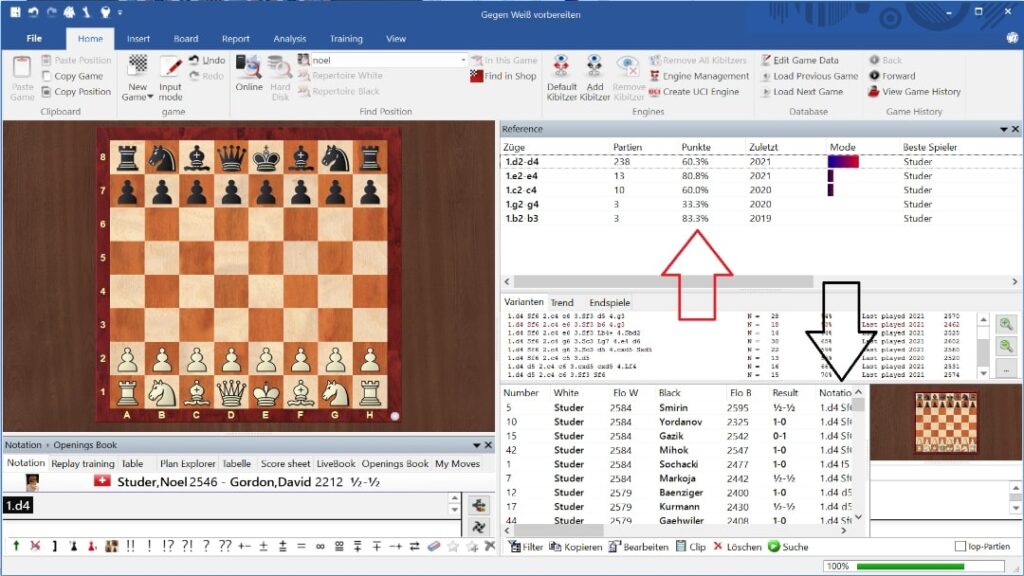
There are dozens of things you could track.
Points Scored
One important misconception happens with the “points” on the right side (red arrow).
This percentage shows how much WHITE scored, even if it’s black to move.
Unsurprisingly, I have scored badly (33%) with the tilt move 1.g4 (thanks to my girlfriend for introducing me to this nonsense…) but have a great score with 1.e4 in the last few years.
As I have played e4 from 2008-2015, it is super important to cut out these old games BEFORE starting to analyze.
Why?
Because the statistics would be completely falsified. Who cares what score I had back in 2008 as a 1900 Player?
Also, the number of games would show a totally different thing. Now it is obvious that my main weapon is 1.d4. Adding the hundreds of e4 games played before 2015 you might get the feeling 1.e4 is still my main weapon!
If your opponent has played lots of games, this percentage is a good indicator of whether he scores good or bad. With less than 5 games for a move, I would not consider that percentage too much.
One blunder or lucky win can change that percentage radically then.
Notation
For some reason, my Chessbase is not showing anymore the notation of the games (black arrow in the image above) automatically.
But you can add it by right-clicking on the bar of “Number”, “White” etc., and clicking “show notation”. Then you can drag it to your favorite place.
So why is this important? As the games are sorted chronologically, you will get an immediate overview of the last 5-20 games (depending on how big your screen is).
In my case, you will see that I played 1.d4 all the time in the recent games.
It simply gives you a better overview in a shorter time period.
Titled Tuesday
Be aware that in the newest Mega-Database and Twic-Updates, there are the Titled Tuesday Blitz games inside. Don’t take those games too seriously.
You can copy those games and put them into the other Blitz games you have downloaded before. Having them together with the Classical games will skew the stats and give you a wrong impression.
Don’t get all worried about some weird openings (like 1.g4 for me) if it is simply titled (or tilted, nobody knows…) Tuesday game.
Here is a summary of Step 2, Analyzing the Games of the opponent:
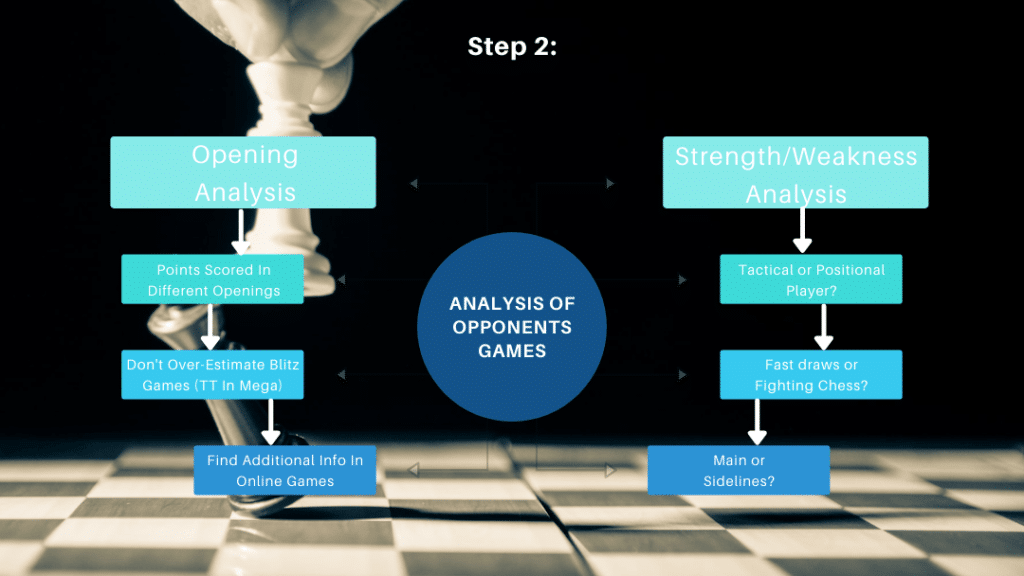
3. Taking An Opening Choice Decision (0-15 min)
Now that you have all the information analyzed, it is time to make a smart decision based on the first two steps. Obviously, you only have to make such a decision if you have any choice.
In the case that you are only playing one opening, you won’t need to decide. You can directly go to step 4. But if you have a choice, then this step is crucial.
The goal is to take the opening decision with the highest expected score.
Things that should flow into your evaluation are:
- Your Strengths And Weaknesses
- Opponent Strengths and Weaknesses
- Your Favorite Openings
- Favorite/Worst Scoring Openings Of the Opponent
Only in very seldom cases, you should also think about the hoped-for result.
Let’s say you need to win for a Norm, so choosing a line that could end with move repetition on move 15 would not be very smart in that case…
The best-case scenario is to find an opening that:
- Is your favorite type of position
- Type of position you consider a weakness of your opponent
- An opening you already play and have experience in
- An opening your opponent scores badly in or has little experience

If that opening gives you a 0.2, 0.01, or 0.4 advantage does not really matter! It is way more important that you feel comfortable and your opponent doesn’t!
You should not play an objectively lost line only because your opponent doesn’t like tactics. However, it is fine to take a bit more risk if you feel your opponent will be uncomfortable in a Gambit type of position.
I see it happen again and again that people go into the complete opposite of a perfect choice just because they think they have found a “small advantage” somewhere.
It is one reason behind my huge success with the French Tarrasch 3…c5 Variation. I have a lot of experience with the line and it fits my style. People try to “attack” me there with some computer preparation.
But once the preparation is finished, they are in their weak spot and I am in my comfort zone. Game over. I have written about that and much more in my article on opening analysis.
Having a position you like and your opponent doesn’t is so much more important than numerical advantages of +/- 0.X
Decide For Surprises In Advance
One thing that can save you many headaches is to shortly think about possible surprises. If you face a player that nearly only plays 1.d4, still shortly think about your answer to 1.e4.
You should not need to decide between different options for your first move at the board. This gives away that you were heavily unprepared and will make you burn time you might need later on.
So just take a principled decision about what you will do for major surprises on the first moves.
It is nice to sit at the board and know that I will play 1…e5 on 1.e4 immediately, even if it would be the first 1.e4 game by my opponent.
And it might make your opponent worry if you anticipated their surprise. This principled decision should only take seconds and should be done at the same time that you decide on the other openings.
It makes sense to simply play the thing you are most comfortable with when your opponent tries to surprise you.
But it is easier to do it quickly if you have actively decided to do so BEFORE the game.
Once I decided what exactly I will play I will make a list of things that I need to analyze or repeat the morning of the round.
That might look like this:
- Sicilian Rossolimo repetition, 15 min
- Open Sicilian Sveshnikov 7.Nd5 repetition 10 min
- Nimzo Indian (unlikely) 4.f3 repetition 5min
As I have all my files already prepared, I usually don’t need to analyze anything. The only exception is if my opponent has some moves in the Database which I did not check yet.
Then I will check them first thing in the morning, as I want to have enough time to remember that analysis as well.
4. Analyzing And Repeating Lines (MAX 2 HOURS!!!)
The fewer you need to analyze at a tournament, the better it is.
If you want to know how you can build up a repertoire at home so you don’t have to analyze at tournaments, then check this article out.
I usually do the analyzing and repetition on the mornings of a game. I am dedicated to keeping the time short because I want to have energy during the game.
Only on rare occasions will I spend more than 2 hours repeating my files.
In most of these cases, I will be exhausted and play a horrible game, even if I manage to remember my analysis correctly.
If you have a feeling that you need way more than 2 hours to repeat your files and remember them, then it is worth thinking about your approach in general.
Do you really only try to remember the most important things? Are your files looking clean? Did you do tournament files that are much shorter than analysis files?
It is nearly impossible to really remember ALL of your opening files in any case. Even if you check them before a game.
Focus on the two most important things:
- The most likely line to appear on the board
- The line you need to know the theory most (complicated, tactical lines that are very dangerous if you don’t know the exact moves)
In 90% of the cases, your play at the board will then decide the game, not how much you remember!
It is also better to check your files for 1 hour with very good focus than clicking through the files while watching some TV for 5 hours.
To summarize the analysis and repetition:
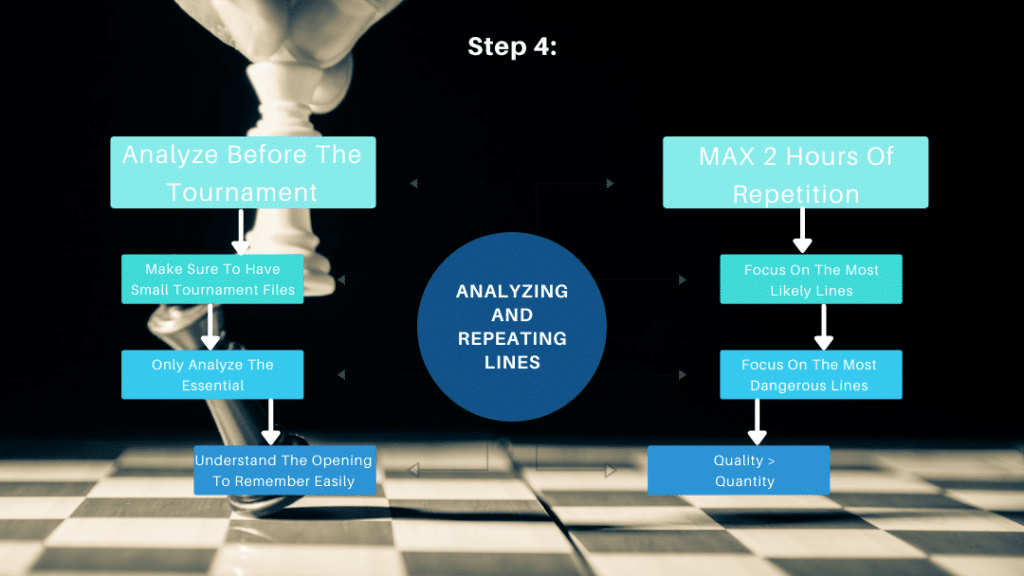
Round-Up:
I know this has been a lot of information and probably also lots of new things. Don’t worry, you don’t need to do ALL of it to see some better results.
Already implementing one or two things can really improve your preparation against another player. This will then increase the likelihood of a positive outcome of the game.
To help you recall the process, I have summarized the essential steps for your preparation below:
Step 1 – Finding The Right Games
- Filter out older games so they don’t falsify the statistics
- Make sure to find all the games of your opponent, try inverting name and surname, or search for a female’s maiden name
- Use OpeningTree to get Online Blitz Games of your opponent
Step 2 – Analyzing Games
- Find out the strengths and weaknesses of your opponent
- Understand the fighting spirit of your opponent
- Check the opening choices and have an eye on the outcome in each possible opening
Step 3 – Choose A Smart Opening
- Opening type to your liking and strengths
- Opening type in your opponent’s weakness
- Your expertise combined with bad results from the opponent
= perfect opening choice.
Step 4 – Analyzing and Repeating The Files
- Do the analysis at home (explained in this article)
- Maximum 2 hours of repetition prior to a game
- Focus on the most likely and most dangerous lines
- Quality > Quantity
I truly hope this helps you prepare better against your opponents and thus get better results out of these games! Let me know if you have any other preparation tips or insights.
Sincerely,
Noël
PS: If you like this article, you will surely also like my FREE guide to organizing your Chess training. Get it HERE.